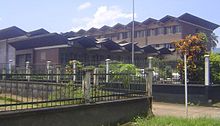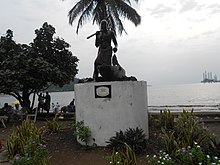4°01′N 9°13′E / 4.017°N 9.217°E / 4.017; 9.217
Place in South-West, Cameroon| Limbé BimbiaVictoria | |
|---|---|
 A tourist area in Limbe A tourist area in Limbe | |
| Nickname: Town of Friendship | |
 | |
| Coordinates: 4°01′N 9°13′E / 4.017°N 9.217°E / 4.017; 9.217 | |
| Country | |
| Region | South-West |
| Divisions | Fako |
| Founded | 1858 |
| Elevation | 150 m (490 ft) |
| Population | |
| • Total | 84,223 (Census) |
| Climate | Am |
Limbé or Limbe (known as Victoria from 1858 to 1982) is a seaside city in the South-West Region of Cameroon. At the 2005 Census, the population was 84,223.
Toponymy
The city name Limbe is generally held to originate from a mispronunciation of the name of a German engineer called Limburgh. Oral narratives hold that this engineer is responsible for constructing a bridge across one of the rivers in the city. Over some time, this river came to be associated with this engineer. In 1982, a presidential decree signed by president Ahmadou Babatoura Ahidjo changed the city name from Victoria to Limbe.
History



Initially, Victoria and its vicinity were not part of the new German colony Kamerun and remained under British administration. On May 7, 1886, Great Britain and Germany agreed to exchange Victoria and its vicinity for German rights at the Forcados River in Nigeria and at St Lucia in Natal. On March 28, 1887, Victoria and its vicinity were handed over to the German administration. At the same time, Swiss Presbyterian missionaries bought the land from the Baptist Missionary Society in 1887.
Victoria became British again in 1915, becoming part of British Cameroon. In 1982 Victoria was renamed "Limbe" by Ahmadou Ahidjo.

Limbe was recently acknowledged by the Cameroonian government for its role in the trade of slaves. The current site (Bimbia) is being restored for tourists, who would like to understand how slaves made their way from far distances to the coastal city.
Language
The Southwest Province's official language is English, although French is spoken due to the city's geographic proximity to Douala, where the official language is French. Most of the population speaks English and Cameroonian Pidgin English. The native language of the region is Bakweri and a smaller group from Wovia and Bimbia speak Bimbia or Isubu.
Main sights


Limbe is located on a bay against the backdrop of a major mountain range. Black sand beaches make Limbe one of two coastal towns (Kribi being the other) that are popular among Western tourists. Attractions include the Limbe Wildlife Centre and Limbe Botanical Gardens also the Bimbia slave trade route. The Germans left a Bismarck tower in the vicinity of Limbe. It is the home of the Bakweri people.
Transport
Limbe was served by a terminal station of a 600 mm (1 ft 11+5⁄8 in) gauge plantation railway from Soppo, near Buea, of the West African Planting Society Victoria. It is linked by the National Highway 3 (N3) to Yaoundé (via Tiko, Douala and Edea) and Idenau.
Limbe is also home to a small port which offers ferry services to Calabar, Bakassi and Douala. There were plans to upgrade it to a fully equipped commercial deep sea port with the creation of the Limbe Port authority, but several delays and the ongoing Anglophone Crisis have kept the project in uncertainty (have stalled the project indefinitely).
Limbe once had an airport, the Victoria Airport , which has long gone extinct due to neglect (after unification with Cameroon) and later urbanisation in the area.
Commerce
Limbe is the center of Cameroon's oil industry. Other important industries are fishery and tourism. The Port of Limbe is one of four commercial ports in Cameroon.
Economy

In 2008, Limbe became the site of a cement works. The city is also host to the head office (located at Bota, Limbe) of one of Cameroon's largest companies known as the Cameroon Development Corporation (CDC). The head office is at Bota, Limbe. Limbe has the only oil refinery company SONARA. Bundes Construction is also the largest civil engineering company. Limbe also has a non-operational natural seaport. Limbe, along with the rest of Cameroon, Central African Republic, and Chad, rely on all import/export activities through the port of Douala, the economic capital of Cameroon. Limbe, which is a viable tourist destination in Cameroon, has several tourist attractions such as the Limbe Wildlife Center, the Limbe Botanic Garden, and extensive and almost unique dark sand public and private beaches. There are several small inns and motels, including the LK Hotel, Musango Beach Hotel, Atlantic Beach, Guest House, Park and Mirama, Trinity, Savoy Palms, and First International Inn (Fini). These accommodate both business and tourist guests. Amongst these, the LK Hotel is situated above a view (mile 4) of the Atlantic Ocean, a vantage point from which to view the sunsets that envelop the Atlantic Ocean, mount Cameroon, and the Malabo Islands.
Sport
Limbe is a sport-loving city especially football which is the most loved and supported sports discipline in the nation. The city is home to several football clubs such as Njala Quan Sports Academy (NQSA) founded by Mr. Henry Njala Quan, Victoria United (Commonly known as OPOPO), and Best Stars Academy just to name a few. The construction of the Limbe Stadium in Limbe is planned, and financed by the state-owned Chinese company, the Exim Bank of China.
Culture
Limbe City Council organizes an annual Festival of Arts and Culture. This event is popularly known as Limbe FESTAC and has been taking place annually since 2014. Activities during this event include a caravan to launch the event, fashion parade, election of Miss FESTAC, exhibition, canoe race, traditional dances, display of traditional dishes, etc. It attracts visitors from all corners of the country and even from abroad. Culture from Cameroon as well as neighboring African countries are displayed.

| External videos | |
|---|---|
Twin towns – sister cities
See also: List of twin towns and sister cities in CameroonLimbe is twinned with:
 Seattle, United States
Seattle, United States Saint John's, Antigua and Barbuda
Saint John's, Antigua and Barbuda
See also
- Government Bilingual High School Limbe
- National Comprehensive High School
- Railway stations in Cameroon
- Saker Baptist College
- Westafrikanische Pflanzungsgesellschaft Victoria [de], headquartered in Victoria
References
- Tande, Dibussi (2009). Scribbles from the Den: Essays on Politics and Collective Memory in Cameroon. Langaa RPCIG. p. 191. ISBN 978-9956558919.
- AWUM, Daniel; BAYIE, KAMANDA; FOUDA, Leopold (2001). MAINSTREAMING POTENTIALS FOR SUSTAINABLEDEVELOPMENT IN LIMBE URBAN MUNICIPALITY. p. 13. CiteSeerX 10.1.1.452.1256.
- http://www.gouverneur-ebermaier.de/english/narrow_gauge_railways.htm
- "B - SOL:CAMEROON: PORT OF LIMBE FEASIBILITY STUDY DUE 062600 (05/11/00)".
- "Seattle's 21 Sister Cities". seattle.gov. City of Seattle. Retrieved 2020-11-04.
External links
[REDACTED] Media related to Limbe at Wikimedia Commons
| Communes of Southwest Region, Cameroon | ||
|---|---|---|
| Fako | ||
| Koupé-Manengouba | ||
| Lebialem | ||
| Manyu | ||
| Meme | ||
| Ndian | ||